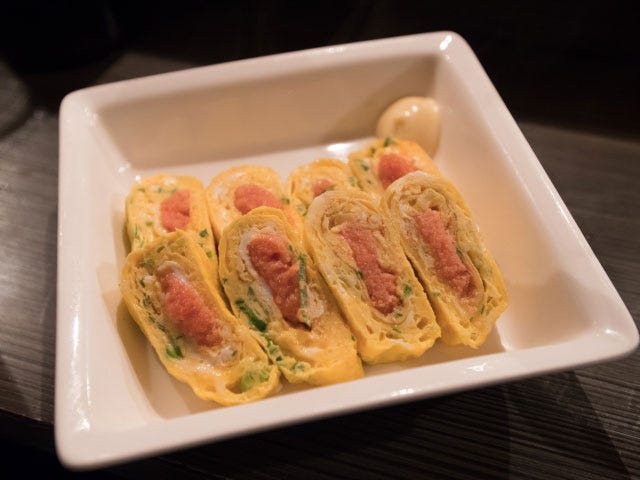Mentaiko / Tarako 明太子 / たらこ
Renowned traditional Japanese seafood ingredients made from the ripe eggs of Alaskan pollock, a cod species.
Although the Alaskan pollock itself belongs to the cod family and not the pollock family, tarako and mentaiko are commonly referred to as cod roe.
These delicate eggs are prepared and seasoned in distinct ways: tarako is typically plain and salted, while mentaiko undergoes marination, resulting in a more flavorful version.

What Are Tarako and Mentaiko?
Tarako comprises salted sacks of pollock or cod roe. The small eggs are tightly packed together and enclosed in a thin membrane.
The Japanese term “tarako” translates to “children of cod,” with “tara” referring to cod and “ko” meaning children.
Tarako is typically sold raw, characterized by its natural color, which ranges from nude to beige with subtle pink undertones. Due to its high appreciation and relative rarity, tarako can be challenging to find and is often quite expensive.
Mentaiko is similar to tarako as it consists of salted cod roe, but it distinguishes itself by undergoing marination with powdered chiles and spices, resulting in various nuanced flavor profiles.
Raw mentaiko is available in different colors, ranging from muted pink to vibrant red, depending on the manufacturer.
Varieties

Mentaiko is sometimes referred to as karashi mentaiko when seasoned with red chili pepper spices or rolled in togarashi, a Japanese red chili pepper, for an added kick.
Uses of Tarako and Mentaiko
Depending on the form in which you purchase the roe, you can enjoy it raw or quickly cook it to your preference. Trimming or discarding is not typically required as the roe is usually sold with its casing intact, and it is up to you whether to remove it or not. Removing the membrane is a simple process that can be done by gently using your hands to free the eggs.
How to Cook With Tarako and Mentaiko
Both tarako and mentaiko can be cooked with or without the exterior membrane of the roe sac. They can be quickly heated in a pan, mixed with pasta, used as stuffing for rice balls or rice dishes, deep-fried, employed as sushi garnish, or combined with mayo to create dips and spreads.
Flavor Profile of Tarako and Mentaiko

Tarako and mentaiko capture the essence of the sea with their salty and seafood-infused flavors, but they do not have an overly “fishy” taste. Tarako offers a plainer flavor profile due to its simple salting process, while mentaiko delivers a kick and rich umami taste resulting from the brining and marinades involved in its preparation.
When cooked while encased in the sac membrane, the tiny roe develops a thick and velvety, almost paste-like texture. When consumed raw, the tiny eggs create a sauce-like consistency that adds a unique touch to dishes.
History of Mentaiko and Tarako
Fish has long been a significant source of protein in Japan due to its surrounded geography. The consumption of fish eggs along with the meat of boiled or grilled fish has been a common practice. However, the exact origins of salting cod roe are unclear.
Some literary evidence suggests its existence during the Edo period. Hokkaido, known for its abundant fish resources, especially pollack roe, played a significant role in the production and distribution of cod roe.
During the Meiji period, the capture of pollack increased, leading to the nationwide popularity of processed fish egg products. This rise in popularity was primarily driven by the efforts to utilize walleye pollock, which had a lesser taste compared to Pacific cod.
While there are theories linking Chinese, Russian, and Korean influences, it is widely believed that Korea had its own version of spicy cod roe, called mentaiko pickles, which served as a prototype.
Local accounts suggest that the founder of “Fukuya” encountered this Korean dish in Busan, adapted it for Japanese palates, and introduced it as spicy cod roe. Interestingly, the Japanese-style spicy cod roe is now being imported back to Korea and gaining popularity.
Ways to eat mentaiko
Mentaiko bread spread
Mentaiko sushi roll

Japanese style pasta
Japanese egg roll

Mentaiko onigiri
I’m just a humble fan who loves all things Japanese and hopes to bring a little bit of that love to you. Arigatou gozaimasu!
Your support holds immense significance for a disabled neurodivergent.
If you’d like to show your support, you can consider buying me a coffee here. Your kindness is greatly appreciated.
Source
「明太子」と「たらこ」の違いは何? 解決!明太子のよくある質問!
たらこって身体に良いの?たらこに含まれる栄養素と期待できる嬉しい効果について解説!
たらこwiki
All photos belong to their respective websites, as indicated in
the captions. For more information, you may click to visit the provided
sources, which will lead to external websites, unless stated otherwise.






Thank you Emika for this, informative and looks yummy.